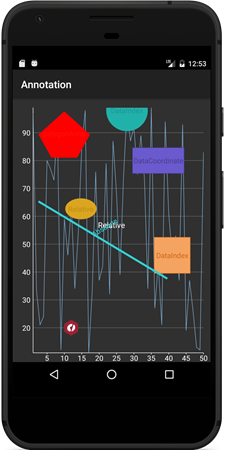Annotations are used to mark important news or events that can be attached to a specific data point on FlexChart. Annotations can also be used to place arbitrary elements such as images, shapes and text onto the chart. The FlexChart control supports various built-in annotations such as Polygon, Line, Ellipsis, Rectangle, Image and Text.
You can specify the position of an annotation on FlexChart by setting the Position property to Bottom, Center, Left, Right or Top. In addition, you can use the Attachment property to specify the type of annotation on FlexChartand set its value to any of the following using AnnotationAttachment enumeration:
The following image shows how FlexChart control appears after applying annotations to it.

Complete the following steps to apply annotations to the FlexChart control:
| C# |
Copy Code |
|---|---|
using System; using System.Collections.Generic; using Android.App; using Android.OS; using Android.Views; using C1.Android.Chart.Annotation; using C1.Android.Core; using C1.Android.Chart; using Android.Graphics; | |
| C# |
Copy Code |
|---|---|
public class AnnotationViewModel { List < DataItem > _data; List < DataItem > _simpleData; Random rnd = new Random(); public List < DataItem > Data { get { if (_data == null) { _data = new List < DataItem > (); for (int i = 1; i < 51; i++) { _data.Add(new DataItem() { X = i, Y = rnd.Next(10, 100) }); } } return _data; } } public List < DataItem > SimpleData { get { if (_simpleData == null) { _simpleData = new List <DataItem> (); _simpleData.Add(new DataItem() { X = 1, Y = 30 }); _simpleData.Add(new DataItem() { X = 2, Y = 20 }); _simpleData.Add(new DataItem() { X = 3, Y = 30 }); _simpleData.Add(new DataItem() { X = 4, Y = 65 }); _simpleData.Add(new DataItem() { X = 5, Y = 70 }); _simpleData.Add(new DataItem() { X = 6, Y = 60 }); } return _simpleData; } } } public class DataItem { public int X { get; set; } public int Y { get; set; } } [Activity(Label = "@string/annotation", Icon = "@drawable/icon")] public class AnnotationActivity: Activity { private FlexChart mChart; protected override void OnCreate(Bundle savedInstanceState) { base.OnCreate(savedInstanceState); SetContentView(Resource.Layout.activity_annotation); // initializing widgets mChart = this.FindViewById < FlexChart > (Resource.Id.flexchart); mChart.ChartType = ChartType.Line; mChart.BindingX = "X"; mChart.Series.Add(new ChartSeries() { SeriesName = "Base dataList", Binding = "Y,Y" }); mChart.ItemsSource = new AnnotationViewModel().Data; mChart.LegendPosition = ChartPositionType.None; Text text = new Text() { Content = "Relative", Location = new C1Point(0.5, 0.5), Attachment = AnnotationAttachment.Relative }; text.AnnotationStyle = new ChartStyle() { FontSize = 15, FontFamily = "GenericSansSerif" }; Ellipse ellipse = new Ellipse() { Content = "Relative", Location = new C1Point(0.4, 0.45), Width = 60, Height = 40, Attachment = AnnotationAttachment.Relative }; ellipse.AnnotationStyle = new ChartStyle() { Fill = Color.Goldenrod, Stroke = Color.Argb(1 * 255, (int)(0.75 * 255), (int)(0.55 * 255), (int)(0.06 * 255)), FontAttributes = TypefaceStyle.Bold, FontSize = 10, FontFamily = "GenericSansSerif" }; Circle circle = new Circle() { Content = "DataIndex", Radius = 40, SeriesIndex = 0, PointIndex = 27, Attachment = AnnotationAttachment.DataIndex }; circle.AnnotationStyle = new ChartStyle() { Fill = Color.LightSeaGreen, Stroke = Color.Argb((int)(1.0 * 255), (int)(0.13 * 255), (int)(0.58 * 255), (int)(0.58 * 255)), FontFamily = "GenericSansSerif", FontAttributes = TypefaceStyle.Bold }; Rectangle rectangle = new Rectangle() { Content = "DataCoordinate", Width = 100, Height = 50, Location = new C1Point(37, 80), Attachment = AnnotationAttachment.DataCoordinate }; rectangle.AnnotationStyle = new ChartStyle() { Fill = Color.SlateBlue, Stroke = Color.Argb((int)(1.0 * 255), (int)(0.29 * 255), (int)(0.25 * 255), (int)(0.57 * 255)), FontFamily = "GenericSansSerif", FontSize = 10 }; Square square = new Square() { Content = "DataIndex", Length = 70, SeriesIndex = 0, PointIndex = 40, Attachment = AnnotationAttachment.DataIndex }; square.AnnotationStyle = new ChartStyle() { Fill = Color.SandyBrown, Stroke = Color.Chocolate, FontAttributes = TypefaceStyle.Bold, FontFamily = "GenericSansSerif" }; Polygon polygon = new Polygon() { Content = "polygonAnno", Attachment = AnnotationAttachment.Absolute }; polygon.Points = CreatePoints(); polygon.AnnotationStyle = new ChartStyle() { Fill = Color.Red, StrokeThickness = 3, Stroke = Color.Argb((int)(1.0 * 255), (int)(0.98 * 255), (int)(0.06 * 255), (int)(0.05 * 255)), FontAttributes = TypefaceStyle.Bold, FontFamily = "GenericSansSerif" }; Line line = new Line() { Content = "Absolute", Start = new C1Point(50, 200), End = new C1Point(300, 350), Attachment = AnnotationAttachment.Absolute }; line.AnnotationStyle = new ChartStyle() { StrokeThickness = 4, FontSize = 10, FontAttributes = TypefaceStyle.Bold, Stroke = Color.Argb((int)(1.0 * 255), (int)(0.20 * 255), (int)(0.81 * 255), (int)(0.82 * 255)), FontFamily = "GenericSansSerif" }; Image image = new Image() { Location = new C1Point(12, 20), Attachment = AnnotationAttachment.DataCoordinate, Width = 30, Height = 30 }; image.Source = BitmapFactory.DecodeResource(this.Resources, Resource.Drawable.xuni_butterfly); AnnotationLayer layer = new AnnotationLayer(ApplicationContext); layer.Annotations.Add(text); layer.Annotations.Add(ellipse); layer.Annotations.Add(circle); layer.Annotations.Add(rectangle); layer.Annotations.Add(square); layer.Annotations.Add(polygon); layer.Annotations.Add(line); layer.Annotations.Add(image); mChart.Layers.Add(layer); } private System.Collections.ObjectModel.ObservableCollection <C1Point> CreatePoints() { System.Collections.ObjectModel.ObservableCollection <C1Point> points = new System.Collections.ObjectModel.ObservableCollection <C1Point> (); points.Add(new C1Point(100, 25)); points.Add(new C1Point(50, 70)); points.Add(new C1Point(75, 115)); points.Add(new C1Point(125, 115)); points.Add(new C1Point(150, 70)); return points; } } | |